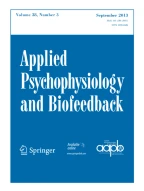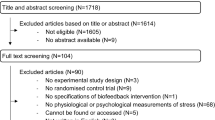The clinical presentation of primary Raynaud’s phenomenon (RP) derives from various pathogenic triggers. The use of thermal biofeedback (TBF) may be of benefit in reducing the severity and frequency of attacks. This article summarizes the relevant research regarding the pathophysiology of primary RP and mechanism of TBF for RP. Systematic reviews of the efficacy of TBF for RP and treatment guidelines for clinicians are provided. The panel concludes that the level of evidence for TBF efficacy is categorized as Level IV: efficacious. The rationale, based on three randomized controlled trials conducted in independent laboratories, demonstrated “superiority or equivalence” of treatments that include TBF. However, randomly controlled trials (RCT) with positive clinical outcomes tended to be small. A large RCT with negative results did not effectively teach handwarming skills. Procedures for reviewing and rating of the levels of evidence of efficacy of studies was based on the Template for Developing Guidelines for the Evaluation of the Clinical Efficacy of Psychophysiological Interventions developed by the joint task force of the AAPB and the Society for Neuronal Regulation (SNR).
Similar content being viewed by others
REFERENCES
Allen, E. V., & Brown, G. E. (1932). Raynaud’s disease: a critical review of minimal requisites for diagnosis. American Journal of Medical Science, 183, 187–200.
Block, J. A., & Sequeira, W. (2001). Raynaud’s phenomenon. The Lancet, 357, 2042–2048.
Cattell, R. B. (1957). IPAT anxiety scale. Institute for Personality and Ability Testing, Champaign, IL.
Coffman, J. D. (1991). Raynaud’s phenomenon. Hypertension, 17, 593–602.
Freedman, R. R., & Ianni, P. (1983). Role of cold and emotional stress in Raynaud’s disease and scleroderma. British Medical Journal, 287, 1499–1502.
Freedman, R. R., Ianni, P., & Wenig, P. (1985). Behavioral treatment of Raynaud’s disease: Long-term follow-up. Journal of Consulting and Clinical Psychology, 53, 136.
Freedman, R. R., Sabharwal, S. G., Ianni, P., Desai, N., Wenig, P., & Mayes, M. (1988). Nonneural beta-adrenergic vasodilating mechanism in temperature biofeedback. Psychosomatic Medicine, 50, 394–401.
Freedman, R. R., Moten, M., Migaly, P., & Mayes, M. (1993). Cold-induced potentiation of a2-adrenergic vasoconstriction in idiopathic Raynaud’s disease. Arthritis and Rheumatism, 36, 685–690.
Gardner-Medwin, J. M., Macdonald, I. A., Taylor, J. Y., Riley, P. H., & Powell, R. J. (2001). Seasonal differences in finger skin temperature and microvascular blood flow in healthy men and women are exaggerated in women with primary Raynaud’s phenomenon. British journal of Clinical Pharmacology, 52, 17–23.
Graafsma, S. J., Wollersheim, H., Droste, H. T., ten Dam, M. A. G. J., van Tits, L. J. H., Reyenga, J., de Miranda, J. F. R., & Thien, T. (1991). Adrenoreceptors on blood cells from patients with primary Raynaud’s phenomenon. Clinical Science, 80, 325–331.
Guglielmi, R. S., Roberts, A. H., & Patterson, R. (1982). Skin temperature biofeedback for Raynaud’s disease: A double-blind study. Biofeedback and Self-Regulation, 7, 99–120.
Jacobson, A. M., Manschreck, T. C., & Silverberg, E. (1979). Behavioral treatment for Raynaud’s disease: A comparative study with long-term follow-up. American Journal of Psychiatry, 136, 844–846.
Jennings, J. R., Maricq, H. R., Canner, J., Thompson, B., Freedman, R. R., Wise, R., et al. (1999). A thermal vascular test for distinguishing between patients with Raynaud’s phenomenon and healthy controls. Raynaud’s Treatment Study Investigators. Health Psychology, 18, 421–426.
Jobe, J. B., Sampson, J. B., Roberts, D. E., & Kelly, J. A. (1986). Comparison of behavioral treatment for Raynaud’s disease. Journal of Behavioral Medicine, 9, 89–96.
Keefe, F. J., Surwit, R. S., & Pilon, R. N. (1979). A 1-year follow-up of Raynaud’s patients treated with behavioral therapy techniques. Journal of Behavioral Medicine, 2, 385–391.
Keefe, F. J., Surwit, R. S., & Pilon, R. N. (1980). Biofeedback, autogenic training, and progressive relaxation in the treatment of Raynaud’s disease: A comparative study. Journal of Applied Behavior Analysis, 13, 3–11.
La Vaque, T. J., Corrydon, H., Trudeau, D., Monastra, V., Perry, J., Lehrer, P., et al. (2002). Template for developing guidelines for the evaluation of the clinical efficacy of psychophysiological interventions. Applied Psychophysiology and Biofeedback, 27(4), 273–281.
LeRoy, E. C., & Medsger, T. A. (1992). Raynaud’s phenomenon: A proposal for classification. Clinical and Experimental Rheumatology, 10, 485–488.
Maricq, H. R., Jennings, J. R., Valter, I., Frederick, M., Thompson, B., Smith, E. A., et al. (2000). Evaluation of treatment efficacy of Raynaud phenomenon by digital blood pressure response to cooling. Raynaud’s Treatment Study Investigators. Vascular Medicine, 5, 135–140.
Maricq, H. R., Valter, I., & Maricq, J. G. (1998). An objective method to estimate the severity of Raynaud phenomenon: Digital blood pressure response to cooling. Vascular Medicine, 3, 109–113.
Middaugh, S. J., Haythornthwaite, J. A., Thompson, B., Hill, R., Brown, K. M., Freedman, R. R., et al. (2001). The Raynaud’s treatment study: Biofeedback protocols and acquisition of temperature biofeedback skills. Applied Psychophysiology and Biofeedback, 26, 251–278.
Raynaud’s Treatment Study (RTS) Investigators. (2000). Comparison of sustained-release nifedipine and temperature biofeedback for treatment of primary Raynaud phenomenon. Archives of Internal Medicine, 160, 1101–1108.
Robinson, M. E., Gagnon, C. M., Riley, J. L., & Price, D. D. (2003). Altering gender role expectations: effects on pain tolerance, pain threshold, and pain ratings. Journal of Pain, 4, 284–288.
Schwartz, M. S., & Sedlacek, K. (2003). Raynaud’s disease: selected issues and considerations in using biofeedback therapies. In M. S. Schwartz, & F. Andrasik (Eds.), Biofeedback: a practitioner’s guide (3rd ed.). (pp. 369–381). NY: The Guilford Press.
Sedlacek, K. (1979). Biofeedback for Raynaud’s disease. Psychosomatics, 20, 535–541.
Sedlacek, K., & Taub, E. (1996). Biofeedback treatment of Raynaud’s disease. Professional Psychology: Research and Practice, 27, 548–553.
Simlan, A., Holligan, S., Brennan, P., & Maddison, P. (1990). Prevalence of symptoms of Raynaud’s phenomenon in general practice. British Medical Journal, 301, 590–592.
Surwit, R. S., Pilon, R. N., & Fenton, C. H. (1978). Behavioral treatment of Raynaud’s disease. Journal of Behavioral Medicine, 1, 323–335.
Taub, E., & School, P. J. (1978). Some methodological considerations in thermal biofeedback training. Behavior Research Methods and Instrumentation, 10(5), 617–622.
Taub, E., & Stroebel, C. F. (1978). Biofeedback in the treatment of vasoconstrictive syndromes. Biofeedback and Self Regulation, 3(4), 363–373.
Thompson, B., Geller, N. L., Hunsberger, S., Frederick, M., Hill, R., Jacob, R. G., et al. (1999). Behavioral and pharmacological interventions: The Raynaud’s treatment study. Controlled Clinical Trials, 20, 52–63.
Turton, E. P. L., Kent, P. J., & Kester, R. C. (1998). The etiology of Raynaud’s phenomenon. Cardiovascular Surgery, 6, 431–440.
Weinrich, M. C., Maricq, H. R., Keil, J. E., McGregor, A. R., & Diat, F. (1990). Prevalence of Raynaud’s phenomenon in the adult population of South Carolina. Journal of Clinical Epidemiology, 43, 1343–1349.
Wigley, F. M. (2002). Raynaud’s phenomenon. New England Journal Medicine, 347, 1001
Author information
Authors and Affiliations
Corresponding author
Rights and permissions
About this article
Cite this article
Karavidas, M.K., Tsai, PS., Yucha, C. et al. Thermal Biofeedback for Primary Raynaud’s Phenomenon: A Review of the Literature. Appl Psychophysiol Biofeedback 31, 203–216 (2006). https://doi.org/10.1007/s10484-006-9018-2
Published:
Issue date:
DOI: https://doi.org/10.1007/s10484-006-9018-2




